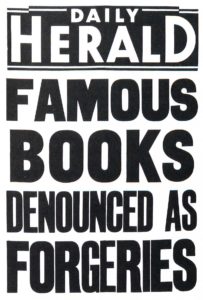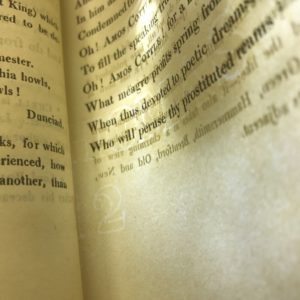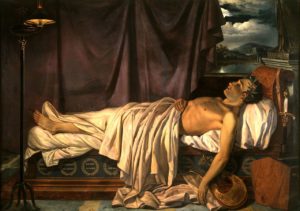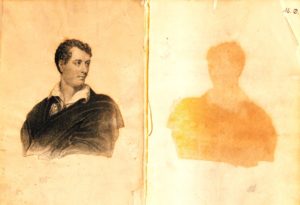(Note: This post was authored by Taylor McNeilly, Processing & Reference Archivist.) This week’s #WyattWalkerWednesday post was intended to be in conjunction with the Wyatt Tee Walker Symposium scheduled for tomorrow afternoon. However, due to Hurricane Florence, the symposium has been canceled. Please check the symposium website for more information about the cancellation and future date once the symposium is rescheduled. And please check back here for a full blog post next week!
Category Archives: Uncategorized
Spuriouser and spuriouser, part III
(Note: This post was authored by Jon Tuttle, Special Formats Cataloger) Boatwright’s 1810, third edition of Lord Byron’s English Bards and Scotch Reviewers is, as its catalog record suggested it might be, a spurious edition. It was most likely produced not in 1810 but two years later and without Byron’s knowledge by his old publisher, James Cawthorn. Reading about our spurious English Bards led me, disorientingly, to three literary forgers: Cawthorn, Thomas James Wise, and George Gordon De Luna Byron, introduced here in a series of three posts that tell the story of a forgery, later verified as such by a forger, who was himself the victim of a forgery.
George Gordon De Luna Byron, a.k.a. de Gibler
While English Bards was flying out of London bookshops, its author toured Cádiz. There, according to one source, Byron met and married a Spanish countess. Returning to England two years later, Byron ignored the marriage, which at that time would have been void anyway. His secret bride, the Countess De Luna, wrote to him from her death bed some thirteen years later, informing him of the existence of their illegitimate son. In Greece and on his own death bed, Byron died before receiving the letter.
This story, which is probably untrue, comes from the man who claimed to be that son of Byron and the Spanish countess, a man who called himself, at times, Major George Gordon De Luna Byron, and, at others, de Gibler. What we know about his adult life, that he was a literary forger, and the fact that no one has corroborated his stories, makes what he wrote about his youth more than a little suspect. He may or may not have studied in Switzerland; he may or may not have lived in Virginia.
We do know he left the States for London in 1844, where he continued a letter-writing campaign to Byron’s publisher and family members. In these elegant, polished letters he laid out his relation to Byron, described his hardships, and asked for money. The year before, he even asked for an example of Byron’s autograph. “No doubt he was even then, in 1843, practising that art of imitation of Lord Byron’s handwriting which later he managed to bring to such a high degree of perfection,” wrote his biographer. For while in London de Gibler began in earnest an entirely different kind of letter-writing campaign, one in which he copied the correspondence of poets like Byron and Shelley, sometimes altering the letters with new texts, perhaps making up some himself, then slipping the letters onto the market.
 Wise, the ubiquitous bibliographer of Byron, whose own stories of an upper class childhood were “probably unprovable” or “probably untrue,” tried to alert the buying public to his predecessor in forgery. In his bibliography of Byron, Wise describes a copy of the authorized second edition of English Bards, which includes an inscription purportedly from Bryon himself: “sun shining Grecianly—Lemon trees in front of the house full of fruit—damn the book!—Give me nature and two eyes opposite.” But the inscription, Wise concludes, “is not genuine. It was the work of the man de Gibler.”
Wise, the ubiquitous bibliographer of Byron, whose own stories of an upper class childhood were “probably unprovable” or “probably untrue,” tried to alert the buying public to his predecessor in forgery. In his bibliography of Byron, Wise describes a copy of the authorized second edition of English Bards, which includes an inscription purportedly from Bryon himself: “sun shining Grecianly—Lemon trees in front of the house full of fruit—damn the book!—Give me nature and two eyes opposite.” But the inscription, Wise concludes, “is not genuine. It was the work of the man de Gibler.”
Wise was not always so quick to ring the alarm, however. He relied in part on an 1872 book called the The Unpublished Letters of Lord Byron to flesh out Byron’s scandalous lifestyle for the two-volume bibliography. Seventeen of the letters are addressed to a lover, “L.,” one of which alludes to a child born out of wedlock: “the child ***** is dead, and I do not regret it, though a bastard Byron is better than no Byron.” Wise could not help but include the story.
Unfortunately The Unpublished Letters of Lord Byron was a dubious volume. Some of the letters were in fact already published, and some of them, like the letter about yet another never-before-mentioned child, were likely created by de Gibler in his campaign to gain proximity to the life and fortune of Byron. Disappointed to discover the book was not what it pretended to be, the publisher pulped all but ten copies of it before sale. One of those copies came to be owned by Harry Buxton Forman, and from Forman it changed hands to his partner, Wise. Byron experts pleaded with him to reconsider mentioning the “L.” letters in his work, but Wise insisted the letters were utterly Byronic; he salted his bibliography with them anyway.
These then were spurious texts cited in a bibliography, which is now cited in the catalog records of spurious books. From the time I began cataloging our copy of English Bards it seemed there was a compromised book under every rock turned. Like all catalogers I stuck to a principal of representation when working with English Bards, representing the book as it represented itself, that is, transcribing things like year and edition from the title page. But in the case of English Bards, representation isn’t enough when telling our students and faculty exactly what we have. A second, more challenging principal, accuracy, instructs catalogers to give extra information correcting any ambiguous or misleading statements. To correct my description of English Bards I reached for reference sources. All confirmed that our edition was spurious, but they also surrounded it with a parade of nineteenth century fraud. With each step in my reading trust gave way and the lesson was repeated: a book is not always what it says it is, a title page can lie to you.
References
Ehrsam, Theodore G. Major Byron: The Incredible Career of a Literary Forger. Charles S. Boesen, 1951.
Barker, Nicolas and John Collins. A Sequel to An Enquiry into the Nature of Certain Nineteenth Century Pamphlets by John Carter and Graham Pollard: the Forgeries of H. Buxton Forman and T.J. Wise Re-examined. Scolar Press, 1983.
Wise, Thomas James. A Bibliography of the Writings in Verse and Prose of George Gordon Noel, Baron Byron. Dawsons of Pall Mall, 1972.
Partington, Wilfred. Thomas J. Wise in the Original Cloth: the Life and Record of the Forger of the Nineteenth-century Pamphlets. Dawsons of Pall Mall, 1974.
Lord Byron on his Death-bed from Wikimedia Commons.
Photograph of inscription from Wise, Thomas James. A Bibliography of the Writings in Verse and Prose of George Gordon Noel, Baron Byron. Dawsons of Pall Mall, 1972.
Spuriouser and spuriouser, part II
(Note: This post was authored by Jon Tuttle, Special Formats Cataloger.) Boatwright’s 1810, third edition of Lord Byron’s English Bards and Scotch Reviewers is, as its catalog record suggested it might be, a spurious edition. It was most likely produced not in 1810 but two years later and without Byron’s knowledge by his old publisher, James Cawthorn. Reading about our spurious English Bards led me, disorientingly, to three literary forgers: Cawthorn, Thomas James Wise, and George Gordon De Luna Byron, introduced here in a series of three posts that tell the story of a forgery, later verified as such by a forger, who was himself the victim of a forgery.
Thomas James Wise
Thomas James Wise is the bibliographer most often cited in catalog records for English Bards. The same record that suggested our 1810 third edition “may be spurious” also referenced Wise’s two-volume study, A Bibliography of the Writings in Verse and Prose of George Gordon Noel, Baron Byron, which details at length eight spurious reprints of the English Bards third edition.
John Carter, a book dealer then in his late-twenties, recognized the Byron bibliography as authoritative when it was published in 1933. Writing for the Times Literary Supplement, he called it “a contribution to its subject of such magnitude and importance as no additions or corrections can sensibly affect.” However, while Carter could not offer any additions or corrections, he did list “certain points and queries.” It was due to these substantial if polite criticisms that Carter decided later that year not to call on the proud Wise, then in his mid-seventies, to discuss a personal project. He sent his research partner, Graham Pollard, in his place.
Pollard, another young book dealer, visited Wise in his London home on the 14th of October. There, he summarized his and Carter’s investigation into the origin of several purportedly first-edition pamphlets that had come onto the market at the turn of the century, titles like “To Be Read at Dusk” by Charles Dickens and Brother and Sister by George Eliot. After analyzing the paper and typefaces used in the pamphlets Carter and Pollard had concluded they were fakes. And since many of them had been bought and vouched for by Wise, they wanted to know if he could account for the discrepancies. They also wanted to know, although they couldn’t explicitly ask, if Wise himself was the forger.
He was. In 1886 Wise had the printer Richard Clay use newly available printing technology to create a facsimile of a Robert Browning first edition for the Browning Society. Facsimile printing taught Wise and fellow bibliographer Harry Buxton Forman how easy it was to make new books look like old books. Together Wise and Forman, working with a witting or unwitting Clay, forged at least 100 pamphlets until around 1900. But instead of meticulously duplicating existing editions, Wise and Forman created their own, backdated editions of known poems and simply called them “first editions.” Half the battle then was not only inventing the edition but inventing the story that would support its origin. In the case of Elizabeth Barrett Browning’s Sonnets from the Portuguese, published in 1850, Wise peddled a story in which the poet was persuaded by her husband to first print the sonnets privately. Wise claimed he had acquired that 1847 private printing when in fact he and Forman had created it decades later.
 Although Wise and Forman’s fakes circulated until the early 30s, there was already a cloud developing over them in the late 1890s: an American dealer in 1898 referred to an “uneasy feeling” and “grave suspicions” about the pamphlets. It was enough of a cloud for Wise to soon cease production of the forgeries. The laugh was with him until 1934, when Carter and Pollard published the result of their investigation, An Enquiry into the Nature of Certain Nineteenth Century Pamphlets. Without direct evidence, their book did not outright accuse Wise of being the forger, but it did nevertheless coolly and ironically place all the available evidence at his doorstep. Irrefutable proof came in 1945, eight years after Wise’s death, when some well-preserved notes between Wise and Forman were finally made public.
Although Wise and Forman’s fakes circulated until the early 30s, there was already a cloud developing over them in the late 1890s: an American dealer in 1898 referred to an “uneasy feeling” and “grave suspicions” about the pamphlets. It was enough of a cloud for Wise to soon cease production of the forgeries. The laugh was with him until 1934, when Carter and Pollard published the result of their investigation, An Enquiry into the Nature of Certain Nineteenth Century Pamphlets. Without direct evidence, their book did not outright accuse Wise of being the forger, but it did nevertheless coolly and ironically place all the available evidence at his doorstep. Irrefutable proof came in 1945, eight years after Wise’s death, when some well-preserved notes between Wise and Forman were finally made public.
And so, after learning from a bibliography about the details of Cawthorn’s forgeries, I discovered the bibliographer himself was a forger. Like Cawthorn, Wise worked from an existing relationship with a printer to take advantage of a demand in the market (though in Wise’s case, there has been speculation about other, less rational motivations—mischief, power, fetishism). Wise even used the bibliographies he wrote to authenticate his forgeries, bibliographies of Swinburne and Ruskin for example.
I hesitated: did Wise use his Byron bibliography to prop up his own Byron forgery? Luckily, I did not see Byron’s name in a list of Wise and Forman’s works; matters then were not complicated by a spurious spurious edition, that is, a Wise fake pretending to be a Cawthorn fake. But my object lesson in the untrustworthiness of books continued. While the discussion of English Bards was free of Wise’s own illicit collaborations, other parts of the bibliography were indeed tainted by the work of another forger altogether.
Next: George Gordon De Luna Byron
References
Carter, John. “Notes on the Bibliography of Byron.” The Times Literary Supplement. 27 April, 1933.
MacDonald, Dwight. “The First Editions of T.J. Wise.” The New Yorker, 10 November 1963, pp. 168-205.
Photograph of Wise from Wikimedia Commons.
Photograph of Pollard and Carter and of Daily Herald headline from: Carter, John and Graham Pollard. An Enquiry into the Nature of Certain Nineteenth Century Pamphlets. 2nd ed. Edited by Nicolas Barker and Joan Collins, Scolar Press, 1983.
Spuriouser and spuriouser, part I
(Note: This post was authored by Jon Tuttle, Special Formats Cataloger.) Boatwright holds a copy of Lord Byron’s English Bards and Scotch Reviewers. “A satire,” it says on the title page, “third edition…printed for James Cawthorn…1810.”
As a cataloger for Rare Books & Special Collections, I set out to record everything I knew about our copy of English Bards: the edition, the publisher, the names on the bookplates. I began by looking for a catalog record that I could build on from among the millions of records shared between libraries. But the record that best matched the details of our copy—third edition, 1810, 85 pages—contained a phrase I had never seen in a record before: “may be spurious.”
Spurious books, I found, are books “printed without the knowledge or consent of the author.” Produced behind the author’s back, they can often be forgeries or piracies. Knowing this, I suddenly wasn’t sure which edition of English Bards we actually had. Was it the third? Was it not? And if I couldn’t trust the details on the title page, what could I trust?
Answering these questions led me to three literary forgers: James Cawthorn, Thomas James Wise, and George Gordon De Luna Byron, introduced here in a series of three posts that tell the story of a forgery, later verified as such by a forger, who was himself the victim of a forgery.
James Cawthorn
Byron began his verse satire, then called British Bards, while a student at Cambridge, but it took on new life and purpose when the Edinburgh Review humiliatingly panned his first book, Hours of Idleness. “As an author,” he wrote, “I am cut to atoms.” His revenge on the critics, English Bards and Scotch Reviewers, was published in London in 1809. It sold through four editions in two years.
By the time the fifth edition was printed and ready to sell, however, Byron saw the poem as a burden to his new, literary friendships: “I can only say that it was written when I was very young and very angry.” He called for the suppression of all existing copies. But public demand ran high. In 1814 his publisher, James Cawthorn, offered Byron 400 guineas for the right to sell the fifth edition copies; again, Byron refused. Meanwhile, pirated copies were selling well. They had Cawthorn’s name on them; some said “third” or “fourth” edition. But they were not printed in the original run of third and fourth editions, and at no point did Byron consent to their publishing. “I have to inform you that the First Edition of the ‘English Bards’ has been pirated in Ireland,” wrote Cawthorn to Byron. “I have a copy of the pirated edition.”
 Long after both Byron and Cawthorn had died bibliographers attempted to sort through this “inextricable tangle” of spurious English Bards editions. They noted, for instance, that some copies of the 1810 third edition bore watermarks with dates after 1810. Reading this, I took up a flashlight, aimed it behind a leaf in our copy, and found exactly the kind of watermarks these bibliographers referred to. Our “1810” English Bards was printed on paper that did not exist until 1812. We had one of the many “poor counterfeits, at the best, of Cawthorn’s work.”
Long after both Byron and Cawthorn had died bibliographers attempted to sort through this “inextricable tangle” of spurious English Bards editions. They noted, for instance, that some copies of the 1810 third edition bore watermarks with dates after 1810. Reading this, I took up a flashlight, aimed it behind a leaf in our copy, and found exactly the kind of watermarks these bibliographers referred to. Our “1810” English Bards was printed on paper that did not exist until 1812. We had one of the many “poor counterfeits, at the best, of Cawthorn’s work.”
Who was making such poor counterfeits of Cawthorn’s work? Some at the time felt it was Cawthorn himself. In 1816 Byron’s new publisher obtained an injunction against Cawthorn, preventing him from ever again printing English Bards. Over a century later, renowned bibliographer Thomas James Wise flatly rejected Cawthorn’s theory of Irish forgers. “No Irish edition that will fit this date is known,” Wise wrote. “There can be but little doubt that the ‘information’ given by Cawthorn to Byron was invented by him, and was concocted with the object of diverting attention from the spurious editions he was himself producing.”
As another bibliographer put it, Cawthorn was “both dishonest and sloppy.” To continue reaping profits from Byron’s popular work, Cawthorn put the already-printed fifth edition in title pages that said “fourth,” and it was likely he that made new editions misleadingly labelled “third”—one copy of which I had in my hands. And the injunction did not stop him. “In 1819 (and perhaps even later),” wrote Wise, “he was still printing and circulating unauthorised editions of the Satire. The laugh was with him after all.”
Next: Thomas James Wise
References
“‘Let Satire Be My Song’: Byron’s English Bards, and Scotch Reviewers. Harvard, http://hcl.harvard.edu/libraries/houghton/exhibits/byron/
Byron, George Gordon Byron. English Bards and Scotch Reviewers. James Cawthorn, 1810 [1812-?].
Wise, Thomas James. A Bibliography of the Writings in Verse and Prose of George Gordon Noel, Baron Byron. Dawsons of Pall Mall, 1972.
Byron, George Gordon Byron. The Works of Lord Byron. Edited by Ernest Hartley Coleridge. John Murray, 1905.
MacAlister, J.Y.W., editor. The Library: A Quarterly Review of Bibliography and Library Lore. Kegan Paul, Trench, Trübner and Co., Ltd., 1900.
Randolph, Francis Lewis. Studies for a Byron Bibliography. Sutter House, 1979.





